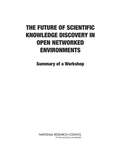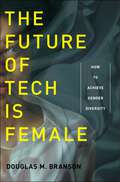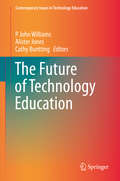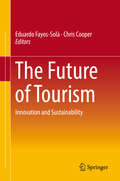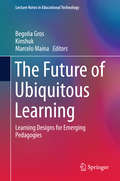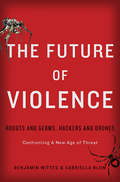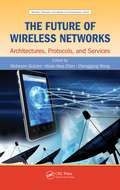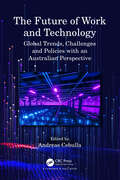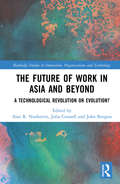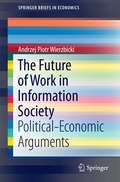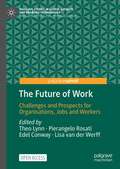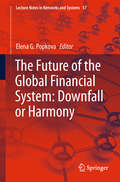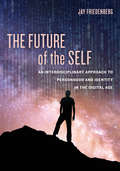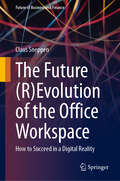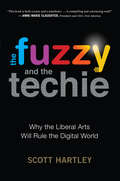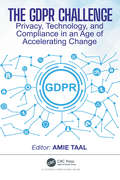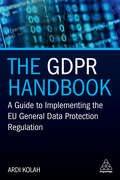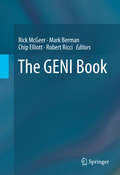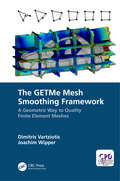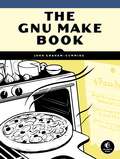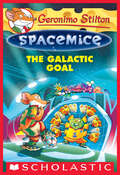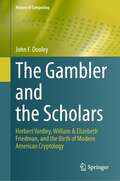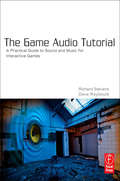- Table View
- List View
The Future of Scientific Knowledge Discovery in Open Networked Environments: Summary of a Workshop
by Paul F. UhlirDigital technologies and networks are now part of everyday work in the sciences, and have enhanced access to and use of scientific data, information, and literature significantly. They offer the promise of accelerating the discovery and communication of knowledge, both within the scientific community and in the broader society, as scientific data and information are made openly available online. The focus of this project was on computer-mediated or computational scientific knowledge discovery, taken broadly as any research processes enabled by digital computing technologies. Such technologies may include data mining, information retrieval and extraction, artificial intelligence, distributed grid computing, and others. These technological capabilities support computer-mediated knowledge discovery, which some believe is a new paradigm in the conduct of research. The emphasis was primarily on digitally networked data, rather than on the scientific, technical, and medical literature. The meeting also focused mostly on the advantages of knowledge discovery in open networked environments, although some of the disadvantages were raised as well. The workshop brought together a set of stakeholders in this area for intensive and structured discussions. The purpose was not to make a final declaration about the directions that should be taken, but to further the examination of trends in computational knowledge discovery in the open networked environments, based on the following questions and tasks: 1. Opportunities and Benefits: What are the opportunities over the next 5 to 10 years associated with the use of computer-mediated scientific knowledge discovery across disciplines in the open online environment? What are the potential benefits to science and society of such techniques? 2. Techniques and Methods for Development and Study of Computer-mediated Scientific Knowledge Discovery: What are the techniques and methods used in government, academia, and industry to study and understand these processes, the validity and reliability of their results, and their impact inside and outside science? 3. Barriers: What are the major scientific, technological, institutional, sociological, and policy barriers to computer-mediated scientific knowledge discovery in the open online environment within the scientific community? What needs to be known and studied about each of these barriers to help achieve the opportunities for interdisciplinary science and complex problem solving? 4. Range of Options: Based on the results obtained in response to items 1-3, define a range of options that can be used by the sponsors of the project, as well as other similar organizations, to obtain and promote a better understanding of the computer-mediated scientific knowledge discovery processes and mechanisms for openly available data and information online across the scientific domains. The objective of defining these options is to improve the activities of the sponsors (and other similar organizations) and the activities of researchers that they fund externally in this emerging research area. The Future of Scientific Knowledge Discovery in Open Networked Environments: Summary of a Workshop summarizes the responses to these questions and tasks at hand.
The Future of Tech Is Female: How to Achieve Gender Diversity
by Douglas M Branson&“Technology has the worst record of promoting and retaining female executive…[This] book wanders through this paradox . . . to provide solutions." —Harvard Law Review Tech giants like Apple and Google are among the fastest growing companies in the world, leading innovations in design and development. The industry continues to see rapid growth, employing millions of people: in the US it is at the epicenter of the American economy. So why is it that only five percent of senior executives in the tech industry are female? Underrepresentation of women on boards of directors, in the C-suite, and as senior managers remains pervasive in this industry. As tech companies are plagued with high-profile claims of harassment and discrimination, and salary discrepancies for comparable work, what prevents women from reaching management roles, and, more importantly, what can be done to fix it?The Future of Tech is Female considers the paradoxes involved in women&’s ascent to leadership roles, suggesting industry-wide solutions to combat gender inequality. Drawing upon fifteen years of experience in the field, Douglas M. Branson traces the history of women in the information technology industry in order to identify solutions for the issues facing women today. Branson unpacks the plethora of reasons women should hold leadership roles, both in and out of this industry. An invaluable resource for anyone invested in gender equality in corporate governance, The Future of Tech is Female lays out the steps toward a more diverse future for women in tech leadership &“[Branson] combines meticulous research and thorough documentation in a very readable, thought-provoking narrative.&” —Choice &“A crucial book on a crucial subject.&” —Deborah Rhode,E.W. McFarland Professor of Law, Stanford University
The Future of Technology Education
by P John Williams Alister Jones Cathy BunttingTwenty-five years ago there was increasing optimism in policy, curriculum and research about the contribution that technology education might make to increased technological literacy in schools and the wider population. That optimism continues, although the status of technology as a learning area remains fragile in many places. This edited book is offered as a platform from which to continue discussions about how technology education might progress into the future, and how the potential of technology education to be truly relevant and valued in school learning can be achieved. The book results from a collaboration between leading academics in the field, the wider group of authors having had input into each of the chapters. Through the development of a deep understanding of technology, based on a thoughtful philosophy, pathways are discussed to facilitate student learning opportunities in technology education. Consideration is given to the purpose(s) of technology education and how this plays out in curriculum, pedagogies, and assessment. Key dimensions, including design, critique, students' cultural capital are also explored, as are the role and place of political persuasion, professional organisations, and research that connects with practice. The discussion in the book leads to a conclusion that technology education has both an ethical and moral responsibility to support imaginings that sustain people and communities in harmony and for the well being of the broader ecological and social environment.
The Future of Tourism: Innovation And Sustainability
by Chris Cooper Eduardo Fayos-SolàThis book presents the foundations for the future of tourism in a structured and detailed format. The who-is-who of tourism intelligence has collaborated to present a definitive blueprint for tourism reflecting the role of science, market institutions, and governance in its innovation and sustainability. The book adopts a comprehensive approach, exploring recent research and the latest developments in practice to inform the reader about instruments and actions that can shape a successful future for tourism. Broad in scope, the book incorporates the perspectives of leading tourism academics, as well as the views of tourism entrepreneurs, destination managers, government officials, and civil leaders. The book is divided into three parts, the first of which addresses the scientific facets of innovation, analyzing the challenges and opportunities that technology provides for organic and disruptive developments in tourism, which will shape its future. In turn, the second part examines socio-cultural paradigms – with a view to dismantling traditional barriers to innovation. It also explores the role of heritage and the ethics of inclusiveness as drivers for sustainable tourism. The third part investigates new ways and means in governance and policy making for tourism. It introduces advances such as strategic positioning, symbiotic partnerships, and innovative management, and closes by presenting governance frameworks for an inclusive and sustainable future of tourism.
The Future of Ubiquitous Learning
by Kinshuk Begoña Gros Marcelo MainaThis book explores emerging pedagogical perspectives based on the design of new learning spaces supported by digital technologies and brings together some of the best research in this field. The book is divided into three themes: foundations of emerging pedagogies, learning designs for emerging pedagogies and, adaptive and personalized learning. The chapters provide up-to-date information about new pedagogical proposals, and examples for acquiring the requisite skills to both design and support learning opportunities that improve the potential of available technologies.
The Future of Violence: Robots and Germs, Hackers and Drones-Confronting A New Age of Threat
by Benjamin Wittes Gabriella BlumThe ability to inflict pain and suffering on large groups of people is no longer limited to the nation-state. New technologies are putting enormous power into the hands of individuals across the world--a shift that, for all its sunny possibilities, entails enormous risk for all of us, and may even challenge the principles on which the modern nation state is founded. In short, if our national governments can no longer protect us from harm, they will lose their legitimacy. Detailing the challenges that states face in this new world, legal scholars Benjamin Wittes and Gabriella Blum controversially argue in [Title TK] that national governments must expand their security efforts to protect the lives and liberty of their citizens. Wittes and Blum show how advances in cybertechnology, biotechnology, and robotics mean that more people than ever before have access to technologies--from drones to computer networks and biological data--that could possibly be used to extort or attack states and private citizens. Security, too, is no longer only under governmental purview, as private companies or organizations control many of these technologies: internet service providers in the case of cyber terrorism and digital crime, or academic institutions and individual researchers and publishers in the case of potentially harmful biotechnologies. As Wittes and Blum show, these changes could undermine the social contract that binds citizens to their governments. In this brave new world of dispersed threats, Wittes and Blum persuasively argue that the best means for safeguarding our liberty and privacy are strong governmental surveillance and security networks. Indeed, they show--through engaging looks at political thinkers from Thomas Hobbes to the Founders and beyond--that security and liberty are mutually supportive, rather than existing in a precarious balance in which the increase in one leads to a proportional decrease in the other. And not only must we bolster our domestic security efforts, but we must think internationally. Our best defense is increasingly a transnational one: more multinational forces and greater action to protect (and protect against) the territory of weaker states who do not yet have the capability to police themselves. [Title TK] is at once an exposé of our emerging world--one in which students can print guns with 3-D printers and scientists’ manipulations of viruses can be recreated and unleashed by ordinary people--and an authoritative blueprint for how government and individuals must adapt to it.
The Future of Wireless Networks: Architectures, Protocols, and Services
by Chonggang Wang Mohesen Guizani Hsiao-Hwa ChenThe exponential increase in mobile device users and high-bandwidth applications has pushed the current 3G and 4G wireless networks to their capacity. Moreover, it is predicted that mobile data traffic will continue to grow by over 300 percent by 2017. To handle this spectacular growth, the development of improved wireless networks for the future ha
The Future of Work and Technology: Global Trends, Challenges and Policies with an Australian Perspective
by Andreas CebullaThis book examines how global technological advances shape the way we work and allocate work today, and how we might do so in the future, exploring advances in robotics, artificial intelligence, green technology and implications for workforce skills and future welfare. It uses Australia as a case study, contrasting the country’s experience to those elsewhere. The book is a cross-disciplinary collaboration that brings together the expertise of engineers, data scientists, economists and sociologists. The reader is offered an overview of the current uses of advanced digital technologies and what it means for today’s workforce, society and economy. The book also looks to the future. Current uses of advanced technologies lag its already existing capability. The contributions note potential future applications of technology and the economic, social and workplace implications of technological change. This book should be of interest to anyone studying and wishing to better understand what work might look like in the future and how we might prepare for likely changes.
The Future of Work in Asia and Beyond: A Technological Revolution or Evolution? (Routledge Studies in Innovation, Organizations and Technology)
by Julia Connell John Burgess Alan R. NankervisThe Future of Work in Asia and Beyond presents the findings and associated implications arising from a collaborative research study conducted on the potential impact of the Fourth Industrial Revolution (4IR – or Industry 4.0) on the labour markets, occupations and associated future workforce competencies and skills across ten countries. The 4IR concerns the digital transformation in society and business – an interface between technologies in the physical, digital and biological disciplines. The book explores many related issues: the nature of the 4IR, as well as demographic, generational and socio-cultural issues, economic and political perspectives, public and private sector similarities and differences, business strategy and managerial implications, human resource management/planning strategies, policies and practices, industry innovations, ‘best practice’ cases and comparative country studies. Chapters are based on a framework which combines labour market and multiple stakeholder theories. Issues are explored through the perceptions of organisational managers based in Australia, China, India, Indonesia, Malaysia, Mauritius, Nepal, Singapore, Taiwan and Thailand to provide an analysis of organisational, industry and government preparedness for the 4IR. This book is recommended reading for anyone wanting to gain an understanding of the 4IR and a range of related challenges and issues, as well as suggested strategies for governments, education and industry that are necessary to address them.
The Future of Work in Information Society
by Andrzej Piotr WierzbickiThis book investigates the questionas to whether technological developments will ultimately mean the end of workand, if so, what the consequences will be. The author addresses this questionfrom the perspective of a technologist well versed in econometrics and gametheory, and argues that it is not technology alone that could lead to the endof work, but its utilization by the capitalist system. Technology allows us tominimize the costs of work and increase profits, while the system is worseningunemployment, socio-economic inequality and stratification - which could lead tothe end of capitalism in a massive global revolution. Assuch, the book proposes an evolutionary reform based on a seemingly minor butin fact essential correction of the corporate income tax, which he proposesshould decrease in accordance with the percentage of the enterprise's revenuesexpended to pay employee salaries. In this way, entrepreneurs will be motivatedto implement new professions and occupations, as well as new workplaces. Onlyin this way, the book argues, can reforms be used to prevent the end of work,which would have catastrophic consequences.
The Future of Work: Challenges and Prospects for Organisations, Jobs and Workers (Palgrave Studies in Digital Business & Enabling Technologies)
by Theo Lynn Pierangelo Rosati Lisa van der Werff Edel ConwayThe COVID-19 pandemic accelerated the adoption of new forms of working and new working arrangements largely enabled by technology. The Future of Work is a projection of how work, working, workers and the workplace will evolve in the years ahead from the perspective of different actors in society, influenced by technological, socio-economic, political, and demographic changes.This open access book is a timely exploration of some of the challenges and prospects for the future of work from two main perspectives: how work is changing and how to prepare for work in the future. An evidence-based assessment of these topics offers some critical perspectives that challenge old assumptions and opens up emerging trends and possibilities for work in the future. As part of the Palgrave Studies in Digital Business & Enabling Technologies series, this book is an essential resource for academics of Business, Human Resource Management, Organisational Psychology and Industrial Relations, as well as practitioners and policy makers.
The Future of the Artificial Mind
by Pietro Perconti Alessio PlebeThe Future of the Artificial Mind is about the social and technological challenges posed by the new wave of artificial intelligence, both from a technical and a cognitive perspective. Deep neural networks have brought about tremendous technological improvements. This renaissance in artificial intelligence, after decades of stagnation, has enabled new technologies capable of surpassing human performance, as in the case of visual recognition. The book reviews the key ideas that have enabled these goals to be achieved and their historical origins. The book also considers some of the ethical and social challenges that the future development of artificial intelligence will face. Will humans fall in love with future android dolls? What will artificial sex be like? And what will it be like to travel in cars that will treat us as passengers instead of drivers? But predicting the future appears more magic than science. But when it comes to artificial intelligence, it is a constant temptation. Since it is well known that "the only way to get rid of a temptation is to enjoy it!", the hypothesis considered in the last chapter is that emerging trends point to a near future in which intelligence will be ubiquitous, but it will be difficult to identify its bearer. We may be heading towards an era of widespread intelligence, but an intelligence without accountability.
The Future of the Global Financial System: Downfall or Harmony (Lecture Notes in Networks and Systems #57)
by Elena G. PopkovaThis book gathers the best papers presented at the conference “The Future of the Global Financial System: Downfall or Harmony”, which took place in Limassol, Cyprus on April 13-14, 2018. Organized by the Institute of Scientific Communications (Volgograd, Russia), the conference chiefly focused on reassessing the role and meaning of the global financial system in the modern global economy in light of the crisis that began in 2008 and can still be observed in many countries, and on developing conceptual and applied recommendations on spurring the development of the global financial system. All works underwent peer-review and conform to strict criteria, including a high level of originality (more than 90%), elements of scientific novelty, contribution to the development of economic science, and broad possibilities for practical application. The target audience of this scientific work includes postgraduates, lecturers at higher educational establishments, and researchers studying the modern global financial system. Based on the authors’ conclusions and results, readers will be equipped to pursue their own scientific research. The topics addressed include (but are not limited to) the following issues, which are interesting for modern economic science and practice: financial globalization, the role of finances in the global economy, perspectives of transition in the financial system from part of the infrastructure to a new vector of development in the global economy in the 21st century, reasons for the crisis of the modern financial system and ways of overcoming it, problems and perspectives regarding the harmonization of the global financial system, and scenarios of development for the global financial system. The content is divided into the following parts: development of financial systems at the micro-, meso- and macro-levels, financial infrastructure of the modern economy, legal issues of development of the modern financial system, and management of the global financial system.
The Future of the Self: An Interdisciplinary Approach to Personhood and Identity in the Digital Age
by Jay FriedenbergWe live in the digital age where our sense of self and identity has moved beyond the body to encompass hardware and software. Cyborgs, online representations in social media, avatars, and virtual reality extend our notion of what it means to be human. This book looks at the progression of self from the biological to the technological using a multidisciplinary approach. It examines the notion of personhood from philosophical, psychological, neuroscience, robotics, and artificial intelligence perspectives, showing how the interface between bodies, brains, and technology can give rise to new forms of human identity. Jay Friedenberg presents the content in an organized and easy-to-understand fashion to facilitate learning. A gifted researcher, author, and classroom teacher, he is one of the most influential voices in the field of artificial psychology.
The Future: How to Succeed in a Digital Reality (Future of Business and Finance)
by Claus SneppenThe redefined meaning of the office workplace for knowledge workers that is currently taking place impacts all workplace actors to different extents. There is no exact formula or framework for a successful hybrid working life, thus society cannot anticipate the future of the hybrid office workplaces and work life will look like for office work. This means that workplaces need to continuously alter and evolved their workplace models. This book provides workers and managers with a nuanced understanding of the changes that have been realized, are nearing realization, or will drive the transformation of the hybrid workplace going forward. It offers recommendations and a framework to assist organizations to develop optimal hybrid workplace models, focusing on major trends and component shaping this evolution.
The Fuzzy and the Techie: Why the Liberal Arts Will Rule the Digital World
by Scott Hartley&“Artfully explains why it is time for us to get over the false division between the human and the technical.&”—Tim Brown, CEO of IDEO and author of Change by Design Scott Hartley first heard the terms fuzzy and techie while studying political science at Stanford University. If you majored in humanities or social sciences, you were a fuzzy. If you majored in computer or hard sciences, you were a techie. While Silicon Valley is generally considered a techie stronghold, the founders of companies like Airbnb, Pinterest, Slack, LinkedIn, PayPal, Stitch Fix, Reddit, and others are all fuzzies—in other words, people with backgrounds in the liberal arts. In this brilliantly counterintuitive book, Hartley shatters assumptions about business and education today: learning to code is not enough. The soft skills—curiosity, communication, and collaboration, along with an understanding of psychology and society&’s gravest problems—are central to why technology has value. Fuzzies are the instrumental stewards of robots, artificial intelligence, and machine learning. They offer a human touch that is of equal—if not greater—importance in our technology-led world than what most techies can provide. For anyone doubting whether a well-rounded liberal arts education is practical in today&’s world, Hartley&’s work will come as an inspiring revelation. Finalist for the 2016 Financial Times/McKinsey Bracken Bower Prize and A Financial Times Business Book of the Month
The GDPR Challenge: Privacy, Technology, and Compliance in an Age of Accelerating Change
by Amie TaalConsent is necessary for collecting, processing and transferring Personal Identifiable Information (PII) and sensitive personal data. But to what extent? What are the limitations and restricts to avoid penalties under The General Data Protection Regulation 2018 (GDPR) rules, which may be up to 4% of annual global turnover or €20 million (whichever is higher), enforcements and sanctions? Under GDPR Article 51, each EU Member State shall maintain an independent public authority to be responsible for monitoring the application of this regulation to protect the fundamental rights of data subjects (Supervisory Authority). The Supervisory Authority has powers to issue warnings, conduct audits, recommend remediation, order erasure of data and suspend data transfers to a third country.GDPR has changed the way data is used, accessed and stored. It's reach extends well beyond the European Union and is the basis of other data privacy laws around the world.This book provides a review and guidance on implementing and compliance of GDPR while taking advantage of technology innovations and supported by real-life examples. The book shows the wide scope of applications to protect data privacy while taking advantage of processes and techniques in various fields such as eDiscovery, Cyber Insurance, Virtual-based Intelligence, Information Security, Cyber Security, Information Governance, Blockchain and Biometric technologies and techniques.
The GDPR Handbook: A Guide to Implementing the EU General Data Protection Regulation
by Ardi KolahThe GDPR Handbook is a thorough introduction to the EU General Data Protection Regulation. It covers in detail how companies of all sizes need to operate within the GDPR requirements and how to deal with information security and risk, and specifically addresses the key duties and responsibilities of the Data Protection Officer.Using the latest research, this book will help Data Protection Officers and businesses carry out Data Protection Impact Assessments, create and enforce data protection policies, train staff and manage data protection teams. The GDPR Handbook is the ultimate, jargon-free guide for any company or organization to interpret GDPR into clear, actionable steps.
The GENI Book
by Rick Mcgeer Mark Berman Chip Elliott Robert RicciThis book, edited by four of the leaders of the National Science Foundation's Global Environment and Network Innovations (GENI) project, gives the reader a tour of the history, architecture, future, and applications of GENI. Built over the past decade by hundreds of leading computer scientists and engineers, GENI is a nationwide network used daily by thousands of computer scientists to explore the next Cloud and Internet and the applications and services they enable, which will transform our communities and our lives. Since by design it runs on existing computing and networking equipment and over the standard commodity Internet, it is poised for explosive growth and transformational impact over the next five years. Over 70 of the builders of GENI have contributed to present its development, architecture, and implementation, both as a standalone US project and as a federated peer with similar projects worldwide, forming the core of a worldwide network. Applications and services enabled by GENI, from smarter cities to intensive collaboration to immersive education, are discussed. The book also explores the concepts and technologies that transform the Internet from a shared transport network to a collection of "slices" -- private, on-the-fly application-specific nationwide networks with guarantees of privacy and responsiveness. The reader will learn the motivation for building GENI and the experience of its precursor infrastructures, the architecture and implementation of the GENI infrastructure, its deployment across the United States and worldwide, the new network applications and services enabled by and running on the GENI infrastructure, and its international collaborations and extensions. This book is useful for academics in the networking and distributed systems areas, Chief Information Officers in the academic, private, and government sectors, and network and information architects.
The GETMe Mesh Smoothing Framework: A Geometric Way to Quality Finite Element Meshes
by Joachim Wipper Dimitris VartziotisHigh quality meshes play a key role in many applications based on digital modeling and simulation. The finite element method is a paragon for such an approach and it is well known that quality meshes can significantly improve computational efficiency and solution accuracy of this method. Therefore, a lot of effort has been put in methods for improving mesh quality. These range from simple geometric approaches, like Laplacian smoothing, with a high computational efficiency but possible low resulting mesh quality, to global optimization-based methods, resulting in an excellent mesh quality at the cost of an increased computational and implementational complexity. <P><P>The geometric element transformation method (GETMe) aims to fill the gap between these two approaches. It is based on geometric mesh element transformations, which iteratively transform polygonal and polyhedral elements into their regular counterparts or into elements with a prescribed shape. GETMe combines a Laplacian smoothing-like computational efficiency with a global optimization-like effectiveness. The method is straightforward to implement and its variants can also be used to improve tangled and anisotropic meshes. <P><P>This book describes the mathematical theory of geometric element transformations as foundation for mesh smoothing. It gives a thorough introduction to GETMe-based mesh smoothing and its algorithms providing a framework to focus on effectively improving key mesh quality aspects. It addresses the improvement of planar, surface, volumetric, mixed, isotropic, and anisotropic meshes and addresses aspects of combining mesh smoothing with topological mesh modification. <P><P>The advantages of GETMe-based mesh smoothing are demonstrated by the example of various numerical tests. These include smoothing of real world meshes from engineering applications as well as smoothing of synthetic meshes for demonstrating key aspects of GETMe-based mesh improvement. Results are compared with those of other smoothing methods in terms of runtime behavior, mesh quality, and resulting finite element solution efficiency and accuracy. <P><P>Features: <li>Helps to improve finite element mesh quality by applying geometry-driven mesh smoothing approaches. <li>Supports the reader in understanding and implementing GETMe-based mesh smoothing. <li>Discusses aspects and properties of GETMe smoothing variants and thus provides guidance for choosing the appropriate mesh improvement algorithm. <li>Addresses smoothing of various mesh types: planar, surface, volumetric, isotropic, anisotropic, non-mixed, and mixed. <li>Provides and analyzes geometric element transformations for polygonal and polyhedral elements with regular and non-regular limits. <li>Includes a broad range of numerical examples and compares results with those of other smoothing methods.
The GLOBAL Optimization Algorithm: Newly Updated With Java Implementation And Parallelization (SpringerBriefs in Optimization)
by Balázs Bánhelyi Tibor Csendes Balázs Lévai László Pál Dániel ZomboriThis book explores the updated version of the GLOBAL algorithm which contains improvements for a local search algorithm and new Java implementations. Efficiency comparisons to earlier versions and on the increased speed achieved by the parallelization, are detailed. Examples are provided for students as well as researchers and practitioners in optimization, operations research, and mathematics to compose their own scripts with ease. A GLOBAL manual is presented in the appendix to assist new users with modules and test functions. GLOBAL is a successful stochastic multistart global optimization algorithm that has passed several computational tests, and is efficient and reliable for small to medium dimensional global optimization problems. The algorithm uses clustering to ensure efficiency and is modular in regard to the two local search methods it starts with, but it can also easily apply other local techniques. The strength of this algorithm lies in its reliability and adaptive algorithm parameters. The GLOBAL algorithm is free to download also in the earlier Fortran, C, and MATLAB implementations.
The GNU Make Book
by John Graham-Cumming<P>GNU make is the most widely used build automation tool, but it can be challenging to master and its terse language can be tough to parse for even experienced programmers. Those who run into difficulties face a long, involved struggle, often leaving unsolved problems behind and GNU make's vast potential untapped. <P>The GNU Make Book demystifies GNU make and shows you how to use its best features. You'll find a fast, thorough rundown of the basics of variables, rules, targets, and makefiles. Learn how to fix wastefully long build times and other common problems, and gain insight into more advanced capabilities, such as complex pattern rules. With this utterly pragmatic manual and cookbook, you'll make rapid progress toward becoming a more effective user. <P>You'll also learn how to: <br>–Master user-defined functions, variables, and path handling <br>–Weigh the pitfalls and advantages of GNU make parallelization <br>–Handle automatic dependency generation, rebuilding, and non-recursive make <br>–Modify the GNU make source and take advantage of the GNU Make Standard Library <br>–Create makefile assertions and debug makefiles <P>GNU make is known for being tricky to use, but it doesn't have to be. If you’re looking for a deeper understanding of this indispensable tool, you'll find The GNU Make Book to be an indispensable guide.
The Galactic Goal (Geronimo Stilton Spacemice #4)
by Geronimo StiltonGeronimo Stilton meets outer space in this cosmically fun spin-off series!The spacemice have received an invitation to participate in the intergalactic soccerix championship. It's a tournament for the most popular sport in space! But Geronimo doesn't even know how to play soccerix, let alone lead a team to victory against aliens with bizarre skills (like flying)! Can the spacemice team prevail?
The Gambler and the Scholars: Herbert Yardley, William & Elizebeth Friedman, and the Birth of Modern American Cryptology (History of Computing)
by John F. DooleyIn May 1917, William and Elizebeth Friedman were asked by the U.S. Army to begin training officers in cryptanalysis and to decrypt intercepted German diplomatic and military communications. In June 1917, Herbert Yardley convinced the new head of the Army’s Military Intelligence Division to create a code and cipher section for the Army with himself as its head. These two seminal events were the beginning of modern American cryptology, the growth of which culminated 35 years later with the creation of the National Security Agency. Each running their own cryptologic agencies in the 1920s, the Friedman-Yardley relationship was shattered after Yardley published a tell-all book about his time in military intelligence. Yet in the end, the work they all started in 1917 led directly to the modern American intelligence community. As they got older, they became increasingly irrelevant in the burgeoning American cryptologic fraternity. Topics and features: * Examines the lives of three remarkable and pioneering cryptologists * Offers fascinating insights into spies, codes and ciphers, rumrunners, poker, and military history * Sheds new light on interesting parts of the cryptologists’ careers—especially Elizebeth Friedman, whose work during World War II has just begun to be explored * Recounts several good stories, i.e., What if the Friedmans had gone to work for Herbert Yardley in his new Cipher Bureau in 1919? What if Yardley had moved back to Washington to work for William Friedman a decade later? This enjoyable book has wide appeal for: general readers interested in the evolution of American cryptology, American historians (particularly of World War I, the inter-war period, and World War II signals intelligence), and historians of—and general readers interested in—American military intelligence. It also can be used as an auxiliary text or recommended reading in introductory or survey courses in history or on the related topics.
The Game Audio Tutorial: A Practical Guide to Creating and Implementing Sound and Music for Interactive Games
by Richard Stevens Dave RaybouldDesign and implement video game sound from beginning to end with this hands-on course in game audio. Music and sound effects speak to players on a deep level, and this book will show you how to design and implement powerful, interactive sound that measurably improves gameplay. If you are a sound designer or composer and want to do more than just create audio elements and hand them over to someone else for insertion into the game, this book is for you. You'll understand the game development process and implement vital audio experiences-not just create music loops or one-off sound effects. The Game Audio Tutorial isn't just a book-you also get a powerful website (www.thegameaudiotutorial.com)
